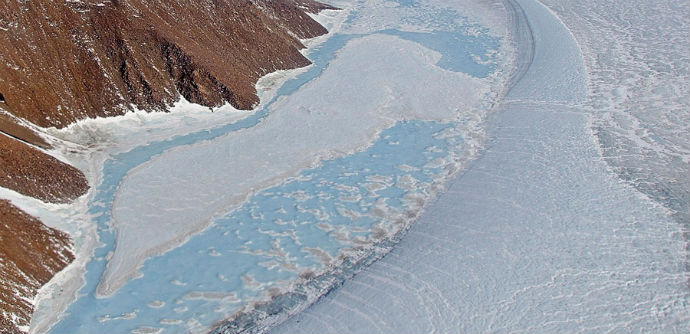Greenland ice loss may be worse than predicted—study

In this NASA handout image obtained December 15, 2014, the glaciers and landscape in northeast Greenland as it looked on April 19, 2013. A warming planet may lead to swifter ice loss on Greenland’s ice sheet, and faster sea level rise for the rest of the world than previously predicted, scientists said Monday. AFP / HANDOUT / NASA / MICHAEL STUDINGER
MIAMI, United States – A warming planet may lead to swifter ice loss on Greenland’s ice sheet, and faster sea level rise for the rest of the world than previously predicted, scientists said Monday.
Two separate international studies raised concern about the pace of ice melt on the world’s second largest ice sheet after Antarctica, and suggested that scientists may have underestimated the variable behavior of Greenland’s ice.
“The current models do not address this complexity,” said Beata Csatho, an associate professor of geology at the University at Buffalo and lead author of the paper in the Proceedings of the national Academy of Sciences, a peer-reviewed US journal.
Currently, scientists use simulations based on the activity of four glaciers — Jakobshavn, Helheim, Kangerlussuaq and Petermann — to build forecasts of melting into the ocean.
But the new PNAS study used NASA satellite data to look at nearly 100,000 points of elevation and how they changed from 1993 to 2012, painting a much fuller picture of where melting has happened in the past.
Article continues after this advertisementResearchers also came up with a new number for how much ice has been lost in recent years on Greenland’s ice sheet. For 2003-2009, the time period with the most accurate data, 243 metric gigatons of ice were lost annually, adding about 0.68 millimeters of water to the oceans each year, said the PNAS study.
Article continues after this advertisement“This information is crucial for developing and validating numerical models that predict how the ice sheet may change and contribute to global sea level over the next few hundred years,” said co-author Cornelis van der Veen, professor in the department of geography at the University of Kansas.
Lakes on the move
A second study in the December 15 issue of the journal Nature Climate Change projects that lakes atop Greenland’s ice sheet will become twice as common in the next 50 years as they are today, and by moving from the coasts to the inland areas they could have a major impact on the way the ice sheet melts.
The bodies of water, known as supraglacial lakes, are darker than other areas, attracting more sunlight and leaking water that can cause ice nearby to melt.
“Supraglacial lakes can increase the speed at which the ice sheet melts and flows, and our research shows that by 2060 the area of Greenland covered by them will double,” said lead author Amber Leeson from the University of Leeds’ School of Earth and Environment.
When the lakes get large enough, they begin to drain through fractures in the ice, making the entire ice sheet more slippery and prone to faster melting.
Researchers had never before simulated the future behavior of these lakes, which have already been migrating slowly inland since the 1970s.
But using data from the European Space Agency’s Environmental Remote Sensing satellites, they made new simulations of how meltwater will flow and pool on the ice surface to form supraglacial lakes in the years to come.
Today, the bulk of Greenland’s ice sheet is too cold for these lakes to form and they are restricted to band along the coast.
The band has already gained 35 miles (56 kilometers) since the 1970s, and by 2060 the area where these lakes can form will have crept inland up to 68 miles, or about double the area they cover today.
‘Key signal’ of global change
Greenland’s ice sheet is considered an important factor in sea level rise from climate change, and has been expected to contribute nine inches (22 centimeters) by 2100.
Since prior projections did not include the changing behavior of these lakes, those projections may be far short, said the researchers, but just how short has yet to be forecast.
“Because ice losses from Greenland are a key signal of global climate change, it’s important that we consider all factors that could affect the rate at which it will lose ice as climate warms,” said co-author Andrew Shepherd, also from the School of Earth and Environment at the University of Leeds.
“Our findings will help to improve the next generation of ice sheet models, so that we can have greater confidence in projections of future sea-level rise.”
RELATED STORIES
UN panel: 8 reasons to worry about global warming